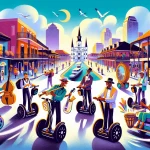New Orleans, a place esteemed for its distinct culture, storied past, and diverse neighborhoods, can be an intricate maze for visitors and even longtime residents. With its meandering streets, varied districts, and numerous attractions, efficient navigation is crucial to fully appreciating the Big Easy’s charms. Maps, both historical and modern, serve as indispensable guides for comprehending and exploring this fascinating city.
In This Article
TL;DR
- Maps are vital tools for navigating New Orleans efficiently, enabling visitors and residents to maximize their time in the city.
- Various map types are available, including historical, cultural, and practical navigation aids, catering to different interests and needs.
- New Orleans maps reflect the city’s unique layout and neighborhoods, showcasing its rich heritage and cultural diversity.
Historical Maps of New Orleans
New Orleans boasts a long and illustrious history, and this is reflected in the evolution of its maps. From the early days of French and Spanish colonial rule to the city’s expansion during the 19th and 20th centuries, historical maps provide a captivating glimpse into the development of New Orleans.
One of the most significant historical maps is the “Plan de la Nouvelle Orleans,” created by French engineer Adrien de Pauger in 1722. This map laid out the city’s original grid pattern, which is still evident in the French Quarter today. Other notable historical maps include the “Norman’s Plan of New Orleans” from 1845, which showcases the city’s growth and development during the antebellum period, and the “Sanborn Fire Insurance Maps” from the late 19th and early 20th centuries, which provide detailed information on individual buildings and their construction materials.
These historical maps can be found at various institutions, such as the Historic New Orleans Collection (533 Royal St, New Orleans, LA 70130; Tuesday-Saturday, 9:30 AM-4:30 PM; free admission) and the Louisiana State Museum (751 Chartres St, New Orleans, LA 70116; Tuesday-Sunday, 10:00 AM-4:30 PM; adults $7, students/seniors/active military $6, children under 7 free).
Modern Navigation Maps
In the digital age, modern navigation maps come in both digital and paper formats, offering real-time information and interactive features. For those exploring New Orleans, popular apps like Google Maps, Apple Maps, and Waze provide up-to-date directions, traffic information, and public transit schedules. These tools are particularly useful during major city events, such as Mardi Gras or Jazz Fest, when road closures and detours are common.
To make the most of these digital tools, be sure to download offline maps before venturing out, as cellular service can be spotty in certain areas of the city. Additionally, consider using the New Orleans Regional Transit Authority’s (RTA) GoMobile app for real-time bus and streetcar tracking and trip planning.
Cultural and Artistic Maps
New Orleans is a haven for art lovers and cultural enthusiasts, and specialized maps cater to these interests. The Arts District New Orleans (ADNO) offers a free, printable map highlighting the city’s premier art galleries, museums, and cultural institutions. This map is perfect for those looking to explore the city’s vibrant arts scene, particularly during events like Art for Arts’ Sake (first Saturday in October) or White Linen Night (first Saturday in August).
Other cultural maps include the “New Orleans Music Map,” which showcases the city’s iconic music venues, and the “New Orleans Literary Map,” highlighting locations associated with famous writers and their works. These maps enhance the visitor experience by providing a curated, thematic exploration of the city.
Geographic Layout and Neighborhoods
Understanding New Orleans’ geographic layout and distinct neighborhoods is essential for efficient navigation and exploration. The city is divided into several key areas, each with its own unique character and attractions.
The French Quarter, the city’s oldest and most famous neighborhood, is known for its historic architecture, lively nightlife, and world-renowned restaurants. The Garden District, located uptown, is characterized by its stunning antebellum mansions, lush gardens, and trendy boutiques. The Marigny and Bywater neighborhoods, located downriver from the French Quarter, are known for their bohemian vibe, thriving arts scene, and eclectic dining options.
Other notable neighborhoods include Treme, the birthplace of jazz; Mid-City, home to the sprawling City Park and the New Orleans Museum of Art; and the Central Business District (CBD), the city’s commercial hub and home to the Mercedes-Benz Superdome.
By familiarizing themselves with these neighborhoods and their locations, visitors can more easily navigate the city and plan their itineraries based on their interests.
Seasonal and Event-Specific Maps
New Orleans is a city that loves to celebrate, and seasonal maps are essential for navigating the numerous festivals and events throughout the year. During Mardi Gras, for example, the city releases official parade route maps, which outline the paths of the various krewes and their floats. These maps also indicate important information such as restroom locations, first aid stations, and designated viewing areas.
Similarly, events like the New Orleans Jazz & Heritage Festival (late April to early May) and the French Quarter Festival (mid-April) provide event-specific maps that highlight stage locations, food and beverage vendors, and other key points of interest. By utilizing these maps, visitors can maximize their event participation and minimize time spent navigating unfamiliar grounds.
Safety and Emergency Maps
Safety is a top priority for both tourists and residents, and having access to up-to-date safety maps is crucial. The City of New Orleans provides a comprehensive “Hurricane Evacuation Map,” which outlines the city’s evacuation zones and routes in the event of a major storm. This map also indicates the locations of emergency shelters and other critical resources.
In addition to the evacuation map, the city also offers a “Flood Map,” which identifies areas prone to flooding during heavy rainfall or storm surge. By familiarizing themselves with these maps, residents and visitors can better prepare for potential emergencies and ensure their safety.
Educational and Community Resources
Maps serve as valuable educational tools in schools and community centers, helping to foster a sense of place and local pride. The New Orleans Public Library system offers a variety of maps and atlases, both historical and contemporary, which can be accessed by students and researchers.
Community-driven map projects, such as the “New Orleans Community Data Center,” provide a wealth of information on the city’s demographics, housing, and economic trends. These resources are invaluable for those seeking to understand the complexities of New Orleans’ social and economic landscape.
Enhancing Map Accessibility
As the importance of maps in navigating New Orleans becomes increasingly evident, efforts are being made to ensure that these resources are accessible to all. The city has partnered with organizations like the Lighthouse Louisiana to provide tactile maps for the visually impaired, allowing them to experience the city’s iconic landmarks and neighborhoods through touch.
Additionally, many of the city’s digital mapping tools, such as the RTA’s GoMobile app, are designed with accessibility features like voice navigation and high-contrast displays. By prioritizing accessibility, New Orleans is working to ensure that everyone can benefit from the wealth of information and resources provided by its maps.
As New Orleans continues to evolve and grow, so too will its maps. By embracing new technologies and community feedback, the city can continue to improve and refine its mapping resources, making navigation and exploration more efficient and enjoyable for all who call New Orleans home or visit this captivating city.






